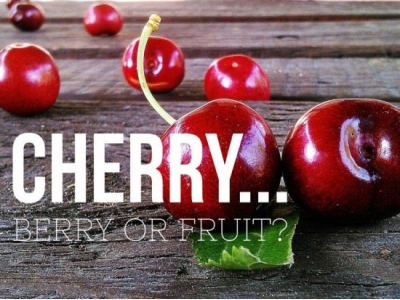Cherry: Berry or Fruit?

If the question of whether a cherry is a fruit or a berry is keeping you up at night, you’ve come to the right place.
HISTORY OF THE CHERRY
But first, a little history. Cherries have been cultivated for thousands of years and probably originated in the area around the Black Sea. Greeks and Romans used them extensively and they soon spread throughout Europe and China.
Early colonists brought cherries to America in the 1600s. Today, over 650 million pounds of cherries are produced commercially in the United States, according to Washington State University. Sweet cherries are preferred for fresh eating, while sour cherries are used for baked goods. Most of the sour cherries grown in the United States come from Michigan. Oregon and Washington are the largest producers of sweet cherries.
CLUES
Cherries look like they might be berries. They are soft, sweet and round, and are about the same size as a strawberry. They are often placed next to strawberries in the produce section of your local grocery store. And while we’re on the subject, what about grapes and cherry tomatoes? They are small, sweet and round, as well.
On the other hand, cherries have one seed like a peach or plum, possibly making them a fruit. Cherries grow on trees, like peaches and plums, and develop from pink or white flowers that bloom in early spring.
ASK A BOTANIST
In botanical terms, berries are actually a type of fruit — they are classified as a subset of ‘simple fleshy fruits.’ A berry is defined as a fruit in which the entire pericarp is fleshy, with one or many seeds. This means that the fruit has no core, and is completely edible. Cherries lack a core and the entire fruit is fleshy, but it has a pit in the center, so it isn’t completely edible. Therefore it does not meet the definition of berry.
Cherries actually fall into a different ‘simple fleshy fruit’ category, called ‘drupe,’ which includes all fruit that has one seed surrounded by a hard shell called a stone. Just as you may have suspected, this category includes peaches, nectarines and plums. So to answer our question: cherries are fruits, and berries are fruits, but cherries are not berries, they are drupes.
So what fruits are berries? Well, cranberries and blueberries are, but would you believe that grapes, tomatoes, papaya, guava, bananas and avocados are also botanically classified as berries? Watermelon and cantaloupes are classified as pepos, or berries with a hard skin. Many fruits commonly called berries, such as raspberries and blackberries aren’t berries at all, but are classified as ‘aggregate fruits’, made up of many tiny drupes clustered together.
CHERRY LOVE
Whether they are fruits or drupes or berries, cherries have long been admired. Historically, cherries were used for making wine, preserves and baked goods, while the resin of cherry trees was used as a cough syrup or treatment for kidney stones and gout. Children chewed the resin as a chewing gum, as well. Interestingly, cherry pits contain small amounts of cyanide and are poisonous.
The bright red color of cherries comes from antioxidants known as anthocyanins. Researchers believe these compounds can reduce inflammation and cholesterol levels and can ease pain caused by arthritis or gout, according to the Cherry Marketing Association.
Prime cherry season is early-to-mid summer, although most stores carry them year round. Juicy, sweet cherries are a treat anytime.
Có thể bạn quan tâm
 How to Grow Verbena
How to Grow Verbena Verbena is a must-have plant for every garden because of its tendency to bloom from spring to fall with very little maintenance.
 How To Freeze Tomatoes: The Go-To Guide to Freezing Your Tomato Harvest
How To Freeze Tomatoes: The Go-To Guide to Freezing Your Tomato Harvest Frozen tomatoes retain their color and a large proportion of their nutrients. However, their texture becomes mushy, though they can still be used in cooking.
 Growing Figs
Growing Figs Fig trees are an often-overlooked backyard tree that produces very tasty, high-nutrition fruits. In many parts of the world, figs are a staple food.